
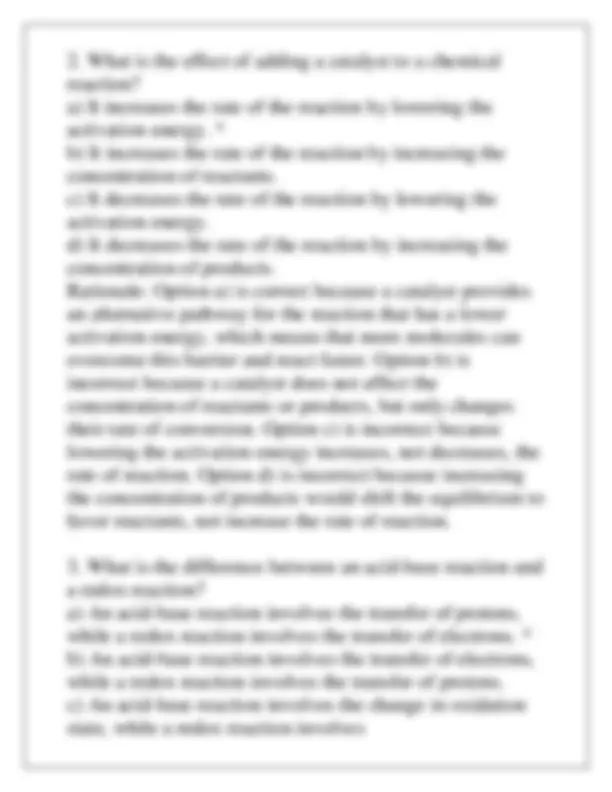

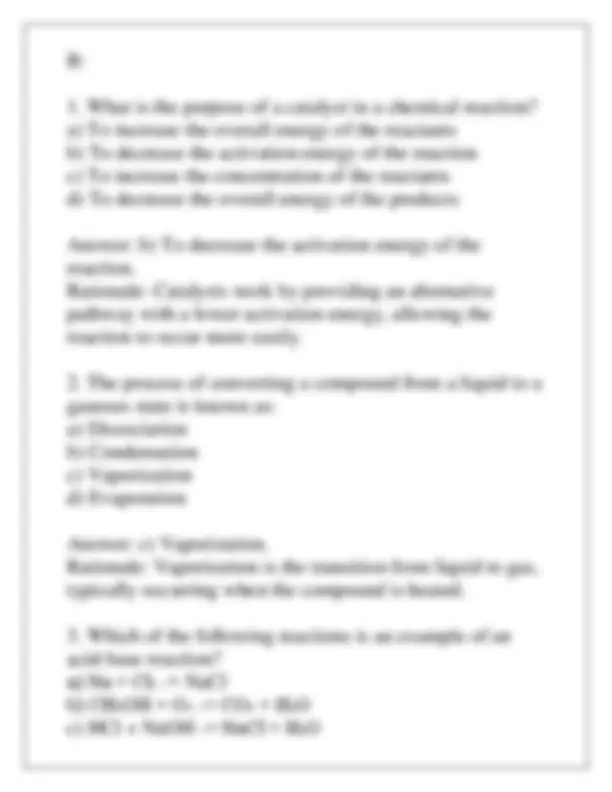

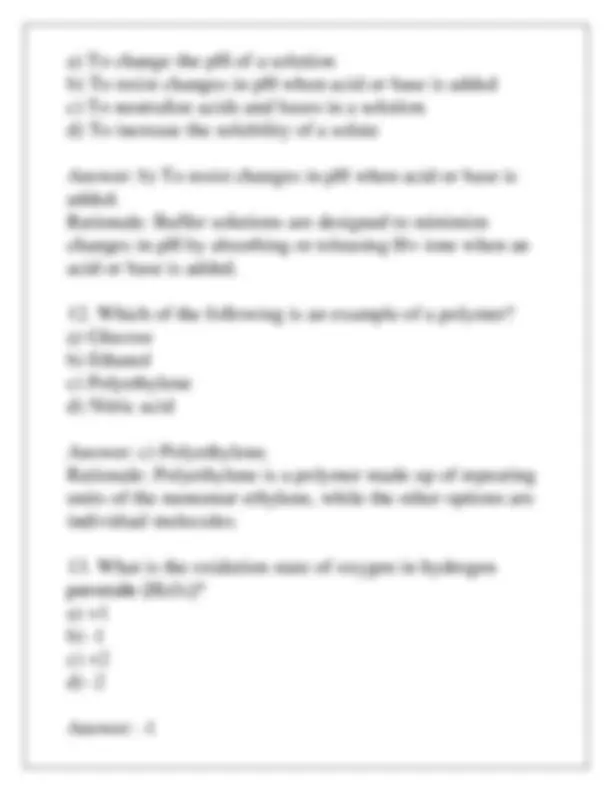
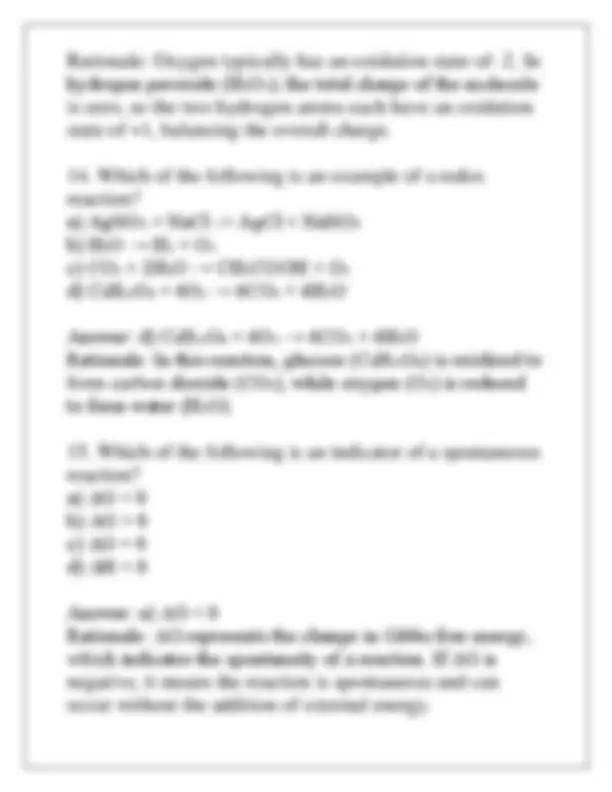
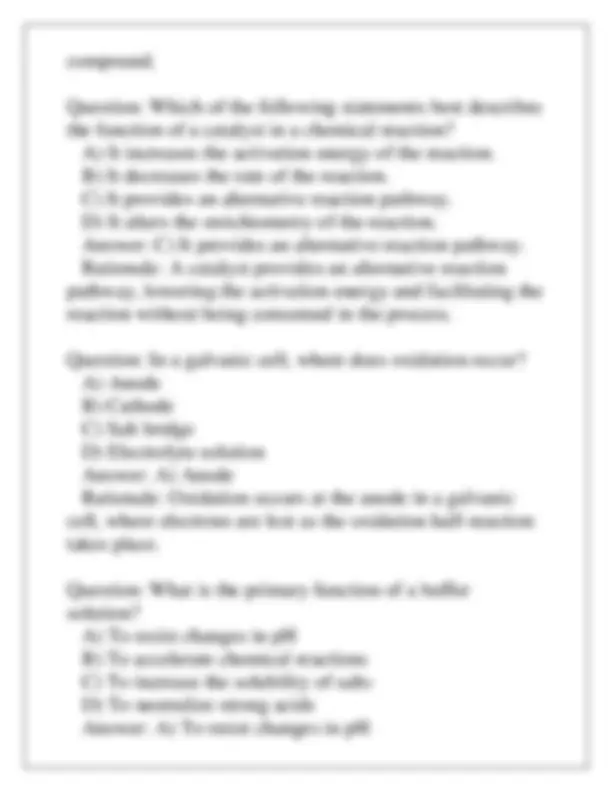
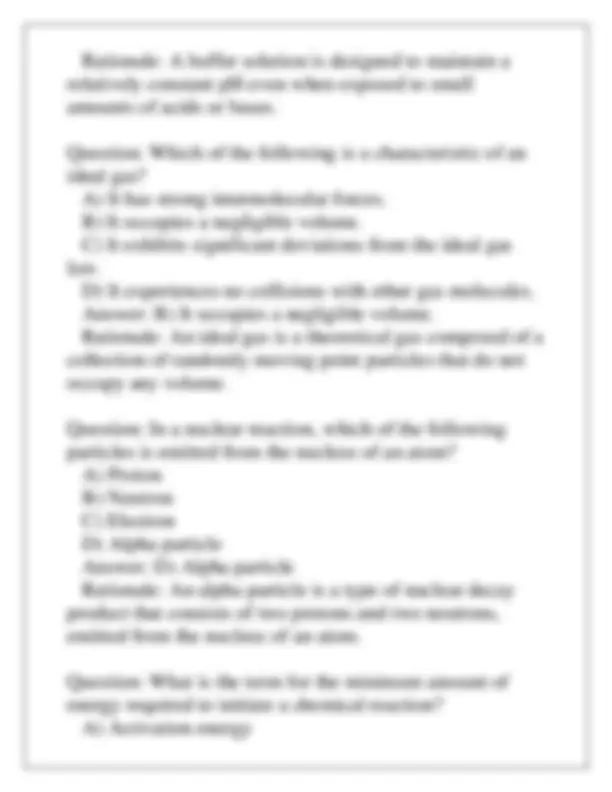
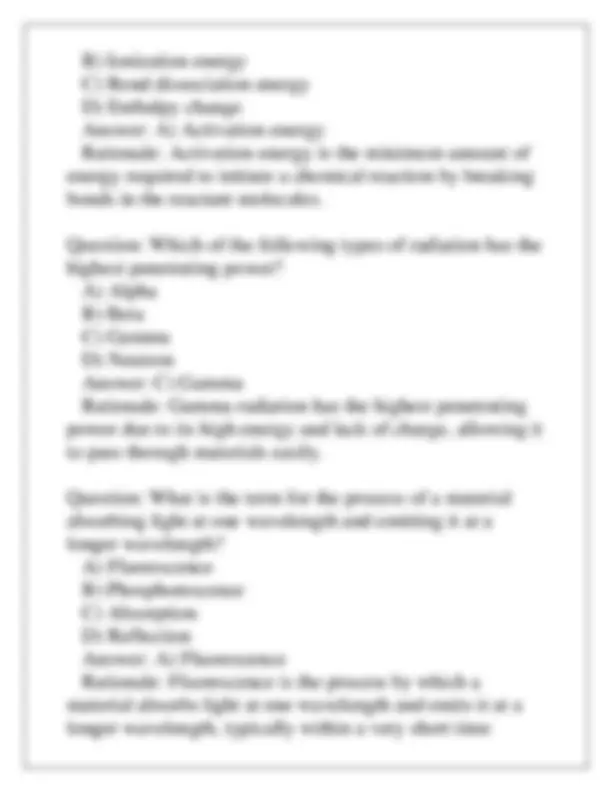


Study with the several resources on Docsity

Earn points by helping other students or get them with a premium plan


Prepare for your exams
Study with the several resources on Docsity

Earn points to download
Earn points by helping other students or get them with a premium plan
Community
Ask the community for help and clear up your study doubts
Discover the best universities in your country according to Docsity users
Free resources
Download our free guides on studying techniques, anxiety management strategies, and thesis advice from Docsity tutors
A series of questions and answers related to advanced chemistry topics, including entropy, Gibbs free energy, catalysts, intermolecular forces, redox reactions, and chemical kinetics. Each question includes a rationale explaining the correct answer. suitable for students studying advanced chemistry at the university level.
Typology: Exams
1 / 16

This page cannot be seen from the preview
Don't miss anything!










the change in pH. d) An acid-base reaction involves the change in pH, while a redox reaction involves the change in oxidation state. Rationale: Option a) is correct because an acid-base reaction is defined as a reaction where an acid donates a proton (H+) to a base, while a redox reaction is defined as a reaction where one species loses electrons (oxidation) and another species gains electrons (reduction). Option b) is incorrect because it reverses the definitions of acid-base and redox reactions. Option c) is incorrect because an acid-base reaction does not necessarily involve a change in oxidation state, and a redox reaction does not necessarily involve a change in pH. Option d) is incorrect because it confuses the effects of acid-base and redox reactions with their definitions.
ionization energy? a) Sodium (Na) b) Potassium (K) c) Calcium (Ca) d) Chlorine (Cl) Answer: d) Chlorine (Cl). Rationale: Chlorine has the highest ionization energy among these options because it requires the most energy to remove an electron from its outer shell.
Answer: b) Covalent bonds. Rationale: Covalent bonds are intramolecular forces occurring within a molecule, while the options listed are intermolecular forces occurring between different molecules.
Rationale: Oxygen typically has an oxidation state of - 2. In hydrogen peroxide (H₂O₂), the total charge of the molecule is zero, so the two hydrogen atoms each have an oxidation state of +1, balancing the overall charge.
Question: A student is conducting an experiment to determine the activation energy of a chemical reaction. Which of the following techniques would be most suitable for this purpose? A) NMR spectroscopy B) X-ray crystallography C) Differential scanning calorimetry D) Mass spectrometry Answer: C) Differential scanning calorimetry Rationale: Differential scanning calorimetry is specifically designed to measure the heat flow into or out of a sample as a function of temperature, making it well- suited for determining activation energy. Question: When a gas is subjected to Boyle's Law, which of the following properties remains constant? A) Temperature B) Volume C) Pressure D) Number of moles Answer: D) Number of moles Rationale: Boyle's Law states that at constant temperature, the product of pressure and volume is constant. Therefore, when pressure and volume change, the number of moles must remain constant. Question: In the context of chemical kinetics, what does the
compound. Question: Which of the following statements best describes the function of a catalyst in a chemical reaction? A) It increases the activation energy of the reaction. B) It decreases the rate of the reaction. C) It provides an alternative reaction pathway. D) It alters the stoichiometry of the reaction. Answer: C) It provides an alternative reaction pathway. Rationale: A catalyst provides an alternative reaction pathway, lowering the activation energy and facilitating the reaction without being consumed in the process. Question: In a galvanic cell, where does oxidation occur? A) Anode B) Cathode C) Salt bridge D) Electrolyte solution Answer: A) Anode Rationale: Oxidation occurs at the anode in a galvanic cell, where electrons are lost as the oxidation half-reaction takes place. Question: What is the primary function of a buffer solution? A) To resist changes in pH B) To accelerate chemical reactions C) To increase the solubility of salts D) To neutralize strong acids Answer: A) To resist changes in pH
Rationale: A buffer solution is designed to maintain a relatively constant pH even when exposed to small amounts of acids or bases. Question: Which of the following is a characteristic of an ideal gas? A) It has strong intermolecular forces. B) It occupies a negligible volume. C) It exhibits significant deviations from the ideal gas law. D) It experiences no collisions with other gas molecules. Answer: B) It occupies a negligible volume. Rationale: An ideal gas is a theoretical gas composed of a collection of randomly moving point particles that do not occupy any volume. Question: In a nuclear reaction, which of the following particles is emitted from the nucleus of an atom? A) Proton B) Neutron C) Electron D) Alpha particle Answer: D) Alpha particle Rationale: An alpha particle is a type of nuclear decay product that consists of two protons and two neutrons, emitted from the nucleus of an atom. Question: What is the term for the minimum amount of energy required to initiate a chemical reaction? A) Activation energy
frame. Question: Which of the following factors can affect the rate of a chemical reaction? A) Temperature only B) Concentration of reactants only C) Pressure only D) Temperature, concentration of reactants, and presence of a catalyst Answer: D) Temperature, concentration of reactants, and presence of a catalyst Rationale: The rate of a chemical reaction can be influenced by temperature, the concentration of reactants, and the presence of a catalyst, all of which impact the collision frequency and energy of the reacting particles. Question: What is the term for a reaction in which the heat content of the system changes? A) Isobaric reaction B) Isothermal reaction C) Adiabatic reaction D) Exothermic reaction Answer: D) Exothermic reaction Rationale: An exothermic reaction is a chemical reaction that releases energy in the form of heat, causing a decrease in the heat content of the system.